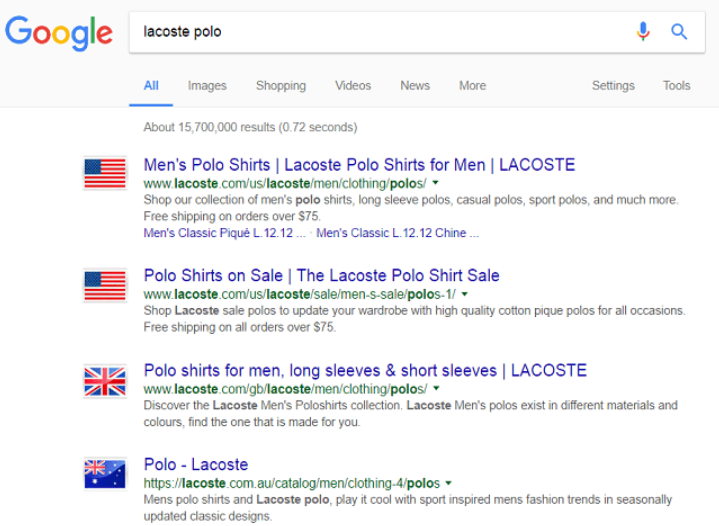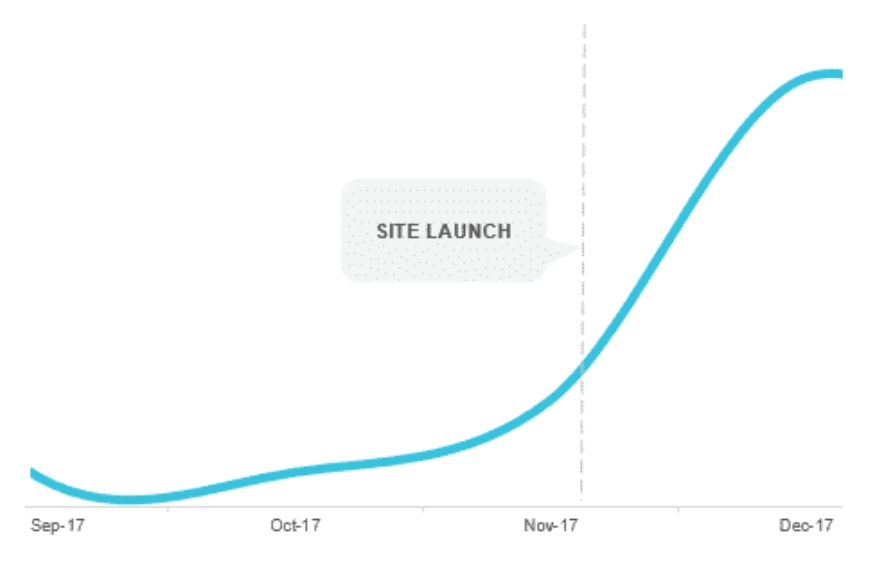Why do you need Hreflang?
Have you ever landed on a multinational brand’s e-commerce store, chosen a sweet new pair of shoes only to find you’re in the incorrect region, unable to checkout? This is a web pet peeve of mine and is all too common among international retailers who struggle to get hreflang right.

To make matters worse, Lacoste USA doesn’t even have a GEO IP lightbox notification to inform me that I landed in the incorrect region. According to SEMRush data, there are thousands of keywords that Lacoste.com is ranking for above Lacoste.com.au, meaning the lack of hreflang tags is costing them thousands of dollars. Multiply that by the number of regions Lacoste operates in, which equals serious money.
How is Hreflang Implemented?
Before implementation, it’s important to understand what type of hreflang implementation is required, whether based on language, location or a combination.
I won’t be going into the nitty gritty aspects around implementation, though it is worth noting that there are three different methods of hreflang implementation:
- HTML <head>
- XML Sitemap
- HTTP header
HTML <head>
Likely the most common form of implementation, the hreflang tags simply sit within the <head> of a page. It is generally the preferred option for developers as it typically takes the least time.
Note: Despite it being a requirement from Google, I have seen hreflang tags working whilst sitting within the <body> of the page code.
XML Sitemap
Instead of having code on each page, one can opt for the XML sitemap method. This has multiple benefits, including:
- Listing all relevant hreflang tags in a single consolidated file
- Ability to reference and set hreflang tags on non-html files (e.g. PDFs)
- Slight reduction of page code (see page speed)
HTTP Header
More relevant to non-HTML sites, this method requires configuration at a server level. This method is likely the most time-consuming and difficult to manage ongoing.
There are pros and cons of each option. Still, from my experience, the best implementation method is the one that works for your business, both from a technological and upkeep perspective, as hreflang is rarely a one-time fix – ongoing love is a requirement.
Does it Work?
You bet. We have seen results in as little as 12 hours post-implementation. A snapshot of our most recent international SEO project can be seen on the left.
Industry: Travel
Issue: Large travel e-commerce site based in Australia with an expanding product. The site previously used sub-domains to target different attractions/destinations; results from Australian SEO traffic were strong. However, there was so much potential to target other regions worldwide.
Solution: As part of a site migration project, Indago Digital identified a significant opportunity to roll out hreflang across the board. We created a global IA that would match origin, destinations and experiences and allow scalability to enable additional experiences and enter other markets.
Results: Australia remained relatively consistent regarding keyword reach and organic traffic (the real goal of any migration project). However, significant growth was seen in other markets where hreflang made a real impact, e.g. India, Singapore, Hong Kong and Germany, all seeing increases of over 350% in keyword reach just two months post-roll-out.

The opportunity
Hreflang is not just for international retailers. Service-based businesses such as TripAdvisor & Airbnb have implemented hreflang in over 50 languages/regions, which has helped them dominate the SERPs for each language/hreflang set. Of course, it doesn’t always make sense to go down the hreflang route, as there are many individual factors to consider, e.g. hosting, domains, infrastructure, localised content and link-building strategy all have to factor in.
Common International SEO Mistakes
Keyword research
Localised keyword research (both on a language & cultural level) is crucial to any international SEO campaign; simply copying the content from one region to another is often not good enough, as different regions/languages search differently. Don’t forget SEO best practices; ensure the content is tailored to your users.
Tags must relate to one another.
For hreflang tags to work, they must “talk” to each other. This means that if you reference one page, that page must reference you back. For example, if we were to open Indago Digital UK, I would have the following code on both Indago Digital UK & Indago Digital Australia:
<link rel=”alternate” hreflang=”en-GB” href=”https://www.indagodigital.co.uk/”/>
<link rel=”alternate” hreflang=”en-AU” href=”https://www.indagodigital.com.au/”/>
Country & language codes
Hreflang requires region & language codes. If you get these wrong, search engines will ignore your tags. Google uses ISO 639 for language codes and ISO 3166-1 alpha-2 regional codes.
Written by
Chloe Zheng





